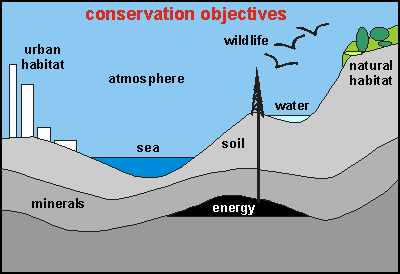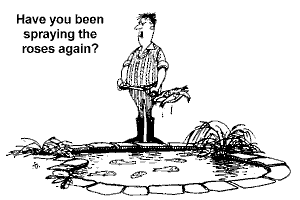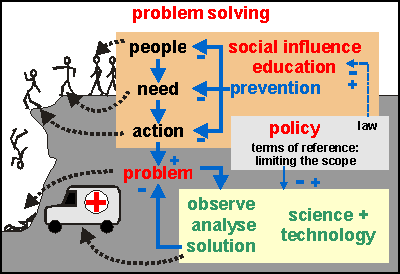Effects of human
activities on our main resources
|
living, working, recreation |
construction,
roading |
transport, movement |
energy & mining |
manufacturing, industry |
agriculture, forestry |
bio
diversity |
cats and dogs, rats, predation,
exotic plants, exotic foods,
diseases, |
development, reclamation,
runoff |
fragmentation by roads,
pollution, roadkill, spread of diseases & pests, |
poison land, poison rivers,
disturbance, |
poisons, |
habitat loss, exotic species,
monocultures, diseases,
competition, |
| habitat |
loss from cities, suburbs,
roads, paving, debris, |
loss from development, reclamation, |
fragmentation, roadkill,
debris, |
disturbance, |
- |
habitat loss, exotic habitats, |
| soil |
reclamation, paving. |
landscaping, disturbance, |
paving, lead, |
spoils, scars, relocation, |
paving, |
erosion, unfertility,
salinisation, |
| water |
sewage, using water, fast
runoff, rapid streamflow, pathogens, |
disturbs hydrology, mud
runoff, |
oil, heavy metals, chemicals,
fast runoff, |
heavy use of water, poisoned
rivers, nuclear wastes, |
heavy use of water, pollution,
poisons, |
aquifer depletion, eutrophication,
biocides, pathogens,
fast runoff, |
| air |
methane, CO2, |
heavy equipment, exhaust, |
exhaust gases, nitric oxides,
ozone, soot, |
exhaust gases, |
poisons, exhaust gases, |
methane, CO2, nitric oxides, |
fish,
sea |
food, fishing, overexploitation,
debris, |
pollution, sediment, |
exotic species, ballast
water, antifouling paint, oil spills, debris, |
poisons, nuclear wastes, |
poisons, |
runoff/erosion, fertiliser,
biocides, eutrophication,
plankton blooms, |
| energy |
electricity, heating, cooking,
refrigerating, airconditioning, plastics, |
use of oil, bitumen, |
use of oil, plastics, |
heavy use, oil, coal, electricity, |
heavy use of energy, |
use of energy, chemicals,
fertiliser, |
| minerals |
various minerals, timber,
concrete, glass, |
various minerals, timber,
concrete, glass, stone, |
various minerals, steel,
aluminium, rubber, |
produces minerals, |
heavy use of minerals, |
fertiliser, |
urban,
human
habitat |
provides culture, crowding,
loss of time, hindrance, |
creates new habitat &
facilities, noise, |
space for roads & parking,
exhaust gases, noise, hindrance, traffic jams, |
- |
provides jobs & income,
pollutes, exhaust gases, uses space, |
- |
This table gives an overview
of the damage caused by what we do. Horizontally our main resources; vertically
our actions. Conservation must be concerned with reducing all threats on
all our resources. Note that the activity of fishing has been left out,
because it has little or no effect on the other resources. Marine conservation
is an entirely separate issue. |
 Nevertheless,
it seems that the three underlying causes, population growth, economic
growth and material needs ('standard of living') are too holy
to be stemmed, or even discussed. So it happens that all our conservation
efforts are directed at fixing problems, rather than preventing them. Worse
still, the concept of sustainable development requires us to increase
economic activity while also conserving the environment, two opposing goals.
Conservationists now try to improve our 'quality of life', the need for
a clean environment, such as clean air and water, uncluttered living areas,
and unspoiled scenic lands. Only very recently has the concept of biodiversity
entered the conservationist's vocabulary. It requires healthy ecosystems,
not just for the benefit of people but also for those other millions of
species. Conservation can be grouped into the following classes:
Nevertheless,
it seems that the three underlying causes, population growth, economic
growth and material needs ('standard of living') are too holy
to be stemmed, or even discussed. So it happens that all our conservation
efforts are directed at fixing problems, rather than preventing them. Worse
still, the concept of sustainable development requires us to increase
economic activity while also conserving the environment, two opposing goals.
Conservationists now try to improve our 'quality of life', the need for
a clean environment, such as clean air and water, uncluttered living areas,
and unspoiled scenic lands. Only very recently has the concept of biodiversity
entered the conservationist's vocabulary. It requires healthy ecosystems,
not just for the benefit of people but also for those other millions of
species. Conservation can be grouped into the following classes: Conservation
is rooted in the belief that something can be done to prevent the loss
of an endeared entity. When we saw native forests disappearing to shipbuilding
and firewood, we began to protect them, goes the story. However, the truth
follows a slightly different path. Forests were saved because people discovered
coal, which was much more efficient to use. Instead of building ships from
timber, steel proved to be a better choice. Instead of burning firewood
for locomotives, coal proved more efficient. Thus coal and steel saved
the remnants of native forests. Likewise it was fossil oil that saved the
whales. If no economic replacement can be found, people will use the resource
to the last little bit. Conservation in its early days, often happened
by accident. However, today, people are using knowledge, foresight, labour
and technology for proactive conservation.
Conservation
is rooted in the belief that something can be done to prevent the loss
of an endeared entity. When we saw native forests disappearing to shipbuilding
and firewood, we began to protect them, goes the story. However, the truth
follows a slightly different path. Forests were saved because people discovered
coal, which was much more efficient to use. Instead of building ships from
timber, steel proved to be a better choice. Instead of burning firewood
for locomotives, coal proved more efficient. Thus coal and steel saved
the remnants of native forests. Likewise it was fossil oil that saved the
whales. If no economic replacement can be found, people will use the resource
to the last little bit. Conservation in its early days, often happened
by accident. However, today, people are using knowledge, foresight, labour
and technology for proactive conservation.
 habitat
loss, disturbance & fragmentation (new): habitat destruction
is by far the most serious of all. By taking the house and livelihood away
from species, they have no place to live, so they die. Once habitats are
changed, the soil and water cycle changes, and everything else with it.
It is unlikely that habitats can ever be restored. It would take thousands
of years.
habitat
loss, disturbance & fragmentation (new): habitat destruction
is by far the most serious of all. By taking the house and livelihood away
from species, they have no place to live, so they die. Once habitats are
changed, the soil and water cycle changes, and everything else with it.
It is unlikely that habitats can ever be restored. It would take thousands
of years. chemical
pollution (new): humans have made a frightening arsenal of new chemicals,
unknown to nature. Many of these are very potent biocides, developed for
this purpose, and such that nature has no defense against them, which renders
them effective for a long time (forever?). Such poisons can accumulate
in organisms all the way up the food pyramid. By means of high level energy,
humans are able to make chemical compounds that won't break down by natural
means. These are valuable to us for their longevity (paints, metals, plastics),
but should not be released into the environment, since nature has no way
of breaking them down.
chemical
pollution (new): humans have made a frightening arsenal of new chemicals,
unknown to nature. Many of these are very potent biocides, developed for
this purpose, and such that nature has no defense against them, which renders
them effective for a long time (forever?). Such poisons can accumulate
in organisms all the way up the food pyramid. By means of high level energy,
humans are able to make chemical compounds that won't break down by natural
means. These are valuable to us for their longevity (paints, metals, plastics),
but should not be released into the environment, since nature has no way
of breaking them down. Since
our threats and problems appear to come from our actions, it stands to
reason that controlling those, would bring solution. However, the path
to a problem consists of several steps, which can all be addressed to solve
or to alleviate our problems. The diagram here shows that problems arise
from a need, which leads to action. To look at problems alone, would bring
costly fixes that do not last. They look like providing ambulances at the
bottom of the cliff, rather than a fence at the top. The best solution
is decreasing human population, then abating our needs, followed by controlling
our actions, and finally by fixing problems.
Since
our threats and problems appear to come from our actions, it stands to
reason that controlling those, would bring solution. However, the path
to a problem consists of several steps, which can all be addressed to solve
or to alleviate our problems. The diagram here shows that problems arise
from a need, which leads to action. To look at problems alone, would bring
costly fixes that do not last. They look like providing ambulances at the
bottom of the cliff, rather than a fence at the top. The best solution
is decreasing human population, then abating our needs, followed by controlling
our actions, and finally by fixing problems. 